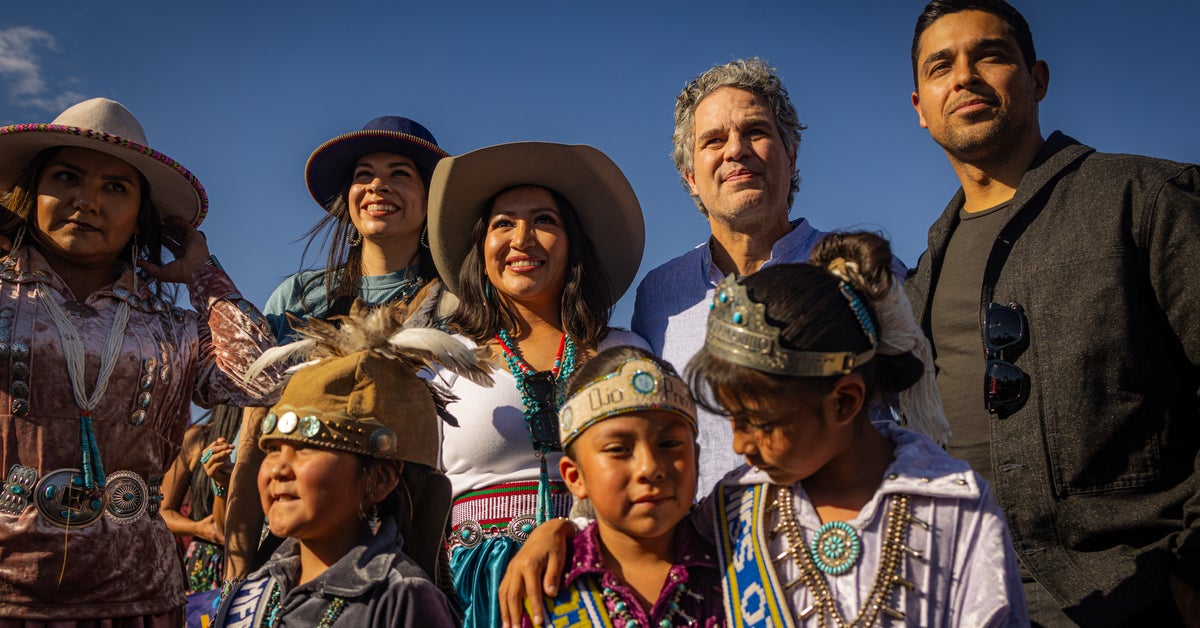FORT DEFIANCE, Ariz. — At an elementary school way out in rural northeastern Arizona, on a sunny Saturday afternoon, the Incredible Hulk was signing autographs.
Hulk was a huge draw in this remote community in Navajo Nation. Hundreds of people turned out for a chance to meet him — well, the actor who plays him in the latest Marvel movies, Mark Ruffalo — at the Tséhootsooí Primary Learning Center. People drove as far as 19 hours, across state lines and with cars full of kids. Some adults even admitted that while they came for the official gathering, an Indigenous voter mobilization event, they wouldn’t turn down a chance to meet a famous actor.
“I’m an active voter. I don’t think that’s enough these days. So, I try to be more than just that,” said Hondo Louis, 50, who was peering around a tree for a Ruffalo sighting as he spoke. “But also, having a celebrity who’s going to lend support to something I believe in.”
Everyone came for an activity, too: a 3-mile walk to a local polling station. Early voting in the state had begun a few days earlier, and residents of all ages — teens on skateboards, elders in wheelchairs — brought their ballots to cast at Fort Defiance Road Yard, a facility that would be open specially for the event.
Ahead of the walk, people talked loosely about what mattered to them in the election. Women’s rights. Better roads. Broadband service.
Most of the attendees live in Navajo Nation, the largest Native American reservation in the country. It is roughly the size of West Virginia and home to nearly 400,000 registered tribal members across three states. Poverty is high. College graduates are scarce. Nearly 1 in 5 people don’t have health insurance. Huge swaths of land haven’t been developed at all, offering drivers stunning views of mesas and desert vegetation on the long and dusty roads between towns.
It took HuffPost 13 hours to get to Window Rock, the capital of the reservation, from Washington, D.C., and another 13 hours to get back. The closest major airport is in Albuquerque, New Mexico, and that’s still two and a half hours away by car.
Most of Navajo Nation is based in northeast Arizona, a pivotal state that Kamala Harris and Donald Trump are fighting to win in these final weeks before the presidential election. Tribes here could be key to deciding who wins.
President Joe Biden won Arizona by just over 10,000 votes in 2020, thanks in part to a huge spike in Indigenous voter turnout. In particular, voters in Apache, Navajo and Coconino counties ― all of which overlap with Navajo Nation ― cast more than 52,000 votes, helping Biden become the first Democrat to win the state since 1996. In Navajo County alone, roughly 66% of registered voters in Navajo precincts voted, which was nearly a 13% increase over the previous presidential election. More than 83% of voters in Navajo Nation precincts went for Biden over Trump.
This isn’t lost on Harris and Trump, who are locked in a tight race and heavily courting voters in Arizona. Both campaigns have teams on the ground targeting tribes, and both candidates have descended on the state in the last couple of weeks.
Harris held an Oct. 10 rally in Chandler, where she met with Native American youth leaders from across the state. Her running mate, Minnesota Gov. Tim Walz, was in Arizona on Oct. 9 to visit the Gila River Indian Reservation. Trump was in Prescott Valley on Oct. 13, and his running mate, Ohio Sen. JD Vance, held events in Tucson and Mesa earlier in the month, too.
But neither Republican engaged directly with tribes during their visit.
During HuffPost’s visit to Navajo Nation, it was clear that Harris is resonating here more than Trump. On the lone highway into Window Rock, two massive billboards stuck out in an otherwise vast landscape of scrub plants and mesas. Both featured distinct images of Trump’s eyes, and underneath, warnings of the threat he poses to women’s reproductive rights and of his ties to Project 2025, the conservative Heritage Foundation’s far-right policy roadmap for a second Trump presidency.
And during Saturday’s walk, where lots of people carried signs celebrating the power of their vote, a few specifically advocated for one candidate: Harris.
“I’ve heard enough. And I’ve read enough. And I’m a motivated voter. And I know B.S. when I hear it,” said Louis, who suggested he didn’t trust Trump. “I feel like I can look somebody in the eye and decide really quickly if they’ve got my vote. Harris and Walz got my vote.”
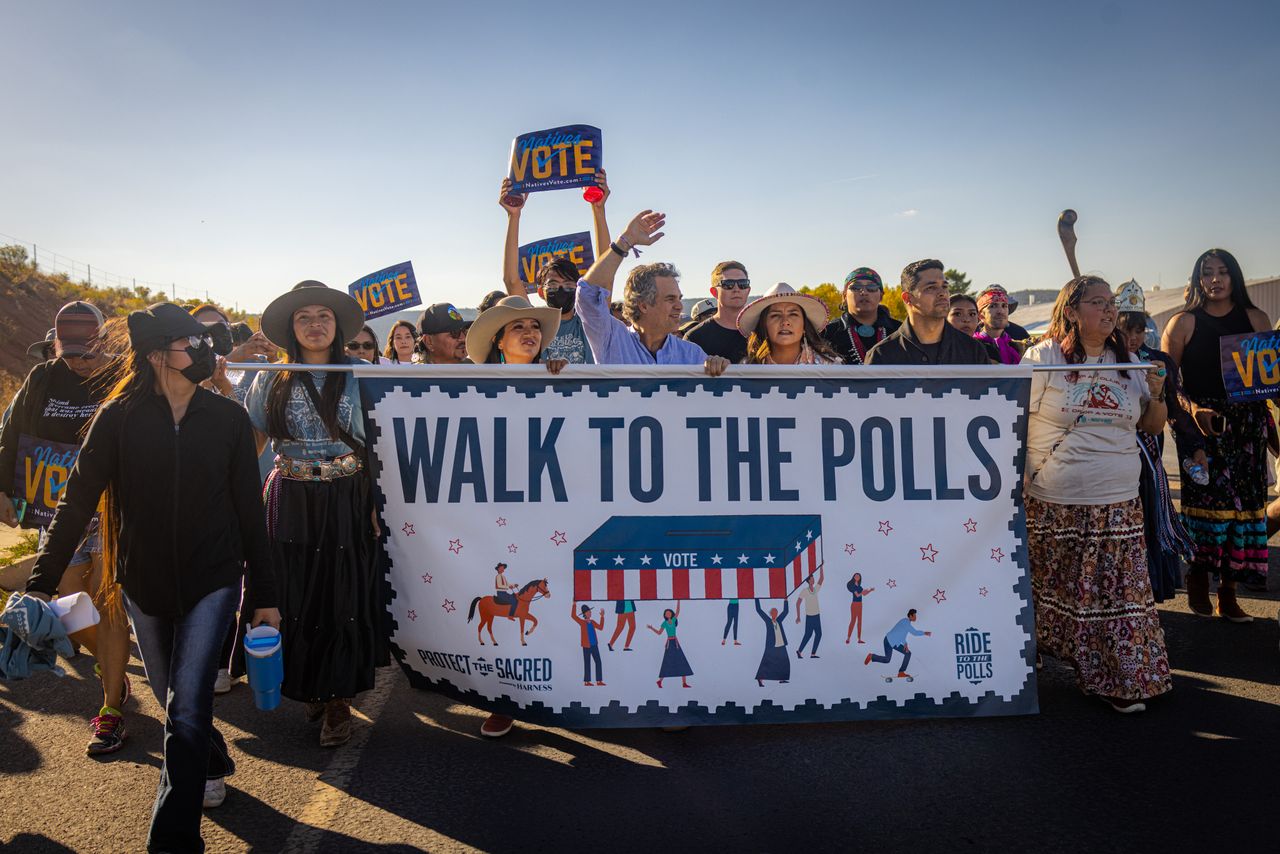
Sharon Chischilly for HuffPost
The voter march, called “Walk to the Polls: Honoring 100 Years of Citizenship and Beyond,” was organized by Protect the Sacred, a group focused on empowering Indigenous youth. Navajo native Allie Redhorse Young launched it in 2020 to mobilize young people to help slow the spread of COVID-19 in Navajo Nation, which was devastated by the pandemic. She has since expanded the group’s focus to civic engagement and voting.
Young’s primary goal is to bring the voting process to Navajo people, many of whom would otherwise have to travel long distances — some as far as 140 miles round trip to the nearest post office — just to register. Lots of people on the reservation still have no water or electricity at home, never mind access to the internet.
“It’s incredibly hard to organize in a rural reservation community, especially around voting,” she told HuffPost. “That’s what I’ve learned in four years of doing this. But I’m constantly telling those funders out there, ‘You guys are neglecting an important voting bloc, and resources need to come to our communities because we make the difference. We do.’”
Young noted that Navajo Nation is 27,000 square miles, most of which is in Arizona, and about 170,000 Navajos still live on the reservation.
“That’s a lot of people we’re not engaging with,” she said. “I’ve had people say, ‘Why can’t we just put on an event in Phoenix?’ No, because our people live five hours from there.”
Some people drove in from much farther away than Phoenix for Young’s event. Maggie Sam, 34, came in from Blanding, Utah, and brought her 19-year-old daughter, Natural Yellowman. Both were clearly excited to meet Ruffalo but said they were eager to vote, too. Both planned to vote for Harris.
“I stand by a lot of things she represents herself, and for us too,” said Sam. “And I really don’t really like the other opponent. So, she has my vote.”
She said it matters a lot to her that Harris is a woman of color, even as Harris has leaned out from showcasing her identity on the campaign trail.
“She’s a minority. And we are too,” said Sam. “We’re brown-skinned.”
Yellowman, who will be a first-time voter, said the first video she saw of Harris was of her talking about women’s rights. She said it really affected her.
“I like that a lot,” said Yellowman, who was holding a painting of the Hulk that she made and planned to give to Ruffalo. “I feel more drawn to her.”
Asked which was more exciting to her, meeting a movie star or voting for Harris, the 19-year-old said softly, “Both.”
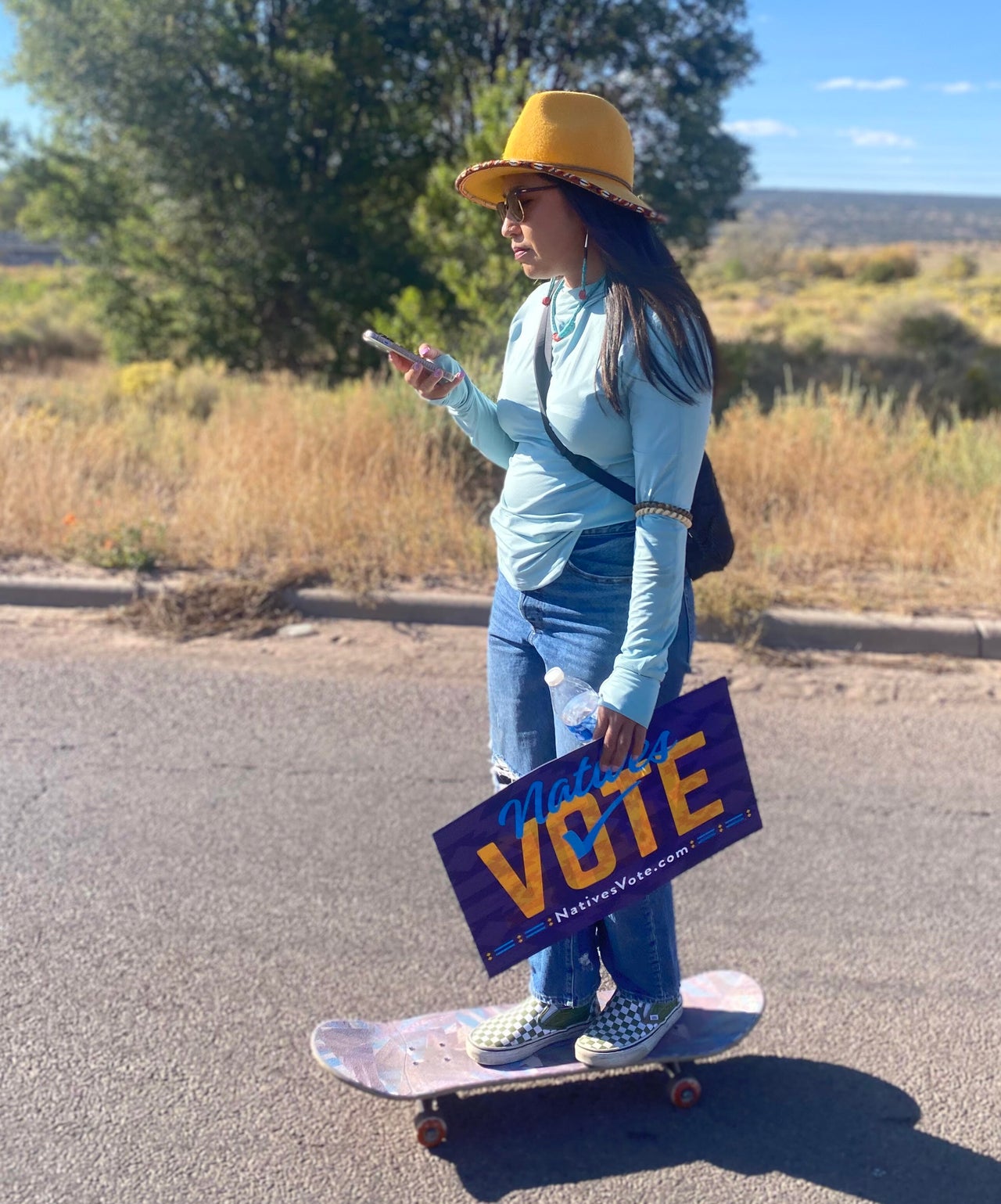
Protect the Sacred’s strategy is pretty simple: Young hosts fun and culturally relevant events that draw out Indigenous youth, and while they’re there, gets them registered to vote. This year, for the first time, Young teamed up with a grassroots group, Arizona Native Vote, to manage voter registration and to stay engaged with event attendees well after the events are over.
Think of it as a one-two punch for Indigenous civic engagement: Protect the Sacred puts together exciting events that young people want to come to, and Arizona Native Vote connects with them while they’re there and adds them to its voter database. It then stays in touch with them year-round to keep them involved and active.
“We do, like, the cool event, and [Arizona Native Vote is] there to do that work,” said Young. “What I realized — because in 2020 and 2022, we were doing similar events — is, what difference are we going to make if we get people to the polls and they’re not registered to vote?”
“So I said, OK, we’ve got to put in the work on the voter registration side,” she said.
Last month, Protect the Sacred held a “Skate for Democracy” event in Tuba City, featuring a skateboarding competition and heavy metal concert where young people could also register to vote. Another event, “Saddle up for Change,” was a six-stop horseback ride across the reservation, with people visiting rural communities to register voters and update their registration status. The events were a hit, and Arizona Native Vote was there for the latter.
“We’re the ground team,” said Jaynie Parrish, executive director of Arizona Native Vote. “We know the voters. We know what needs to be done. We know precincts on tribal lands.”
Parrish launched her nonprofit in early 2023 after years of mobilizing Indigenous voters in the state via the Democratic Party. She and her team have been parsing through precinct data to single out registered voters who didn’t vote in 2020 or 2022 and target them for engagement. They target new voters, like high school and college students, and so-called “voting influencers,” people who regularly vote and can influence their family members to do the same.
“2022 was good,” Parrish said of her voter contact efforts that year. “Our two counties were the only ones in the whole state that saw an increase in voter turnout. Apache and Navajo County. It’s because we do this work year-round.”
“It was a slight increase,” she added, “but still an increase.”
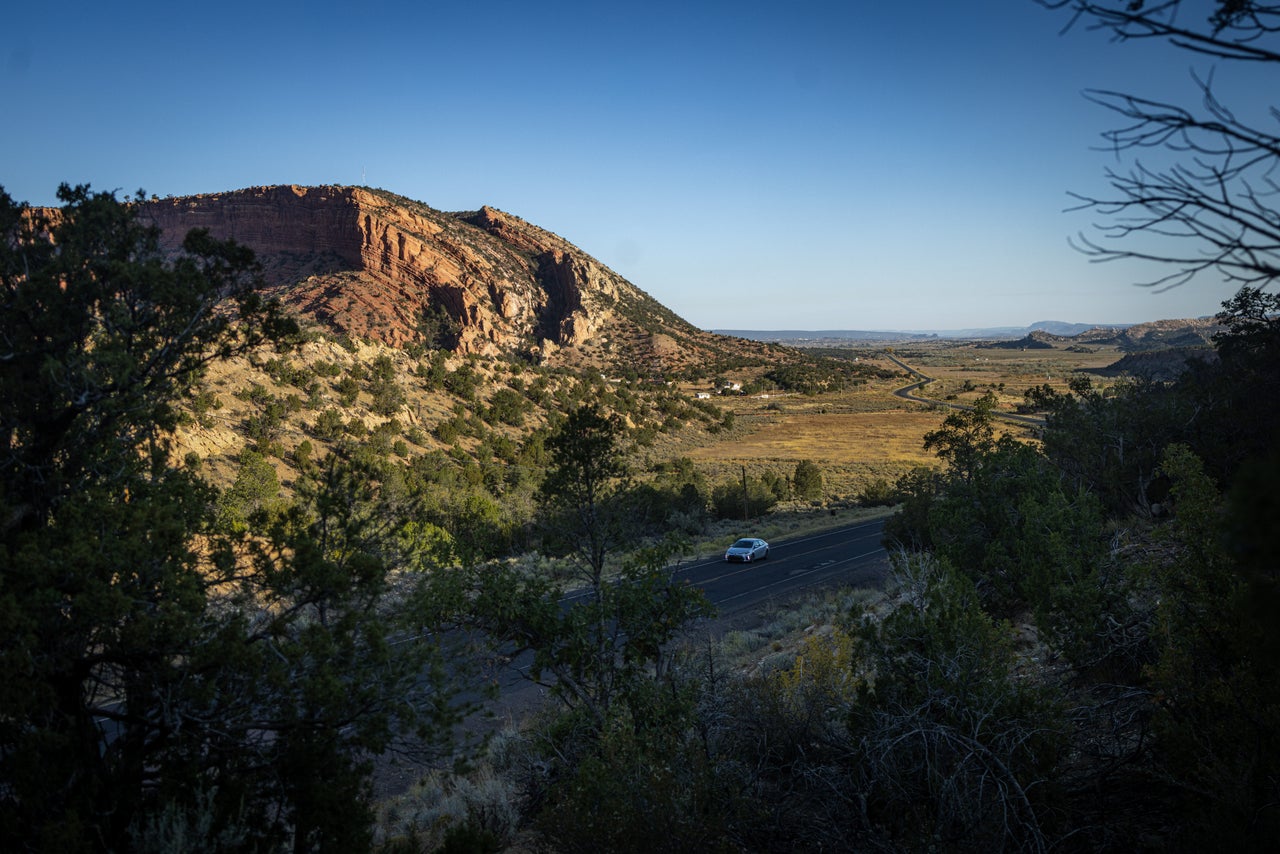
Sharon Chischilly for HuffPost
The walk itself carried cultural significance beyond the current electoral cycle. Young tied it to the 100-year anniversary of the signing of the Indian Citizenship Act, which granted U.S. citizenship to Native Americans. (The irony of being granted rights on their own land was not lost on Young or on anyone who knows what irony means, folks.)
The trek was also inspired by the Navajo Long Walk of 1864, when the U.S. government forced Navajo people from their homelands and made them walk more than 400 miles from Fort Defiance — the location of Saturday’s event — to Bosque Redondo, New Mexico. Thousands of Navajos died during that walk, which was the goal of the U.S. government.
Young wanted to connect her event to that dark era to celebrate how far the Navajo people have come. In a nod to that effort, several people dressed in traditional Indigenous clothing for Saturday’s walk.
One young Navajo woman wearing deer hide wrap moccasins, which have thin soles and aren’t exactly built for long walks on pavement, had to pause because her shoe was unraveling. “It hurts a lot,” she told HuffPost, standing on the side of the road as friends were helping to wrap her shoe back up. Nonetheless, she said she wanted to finish the walk in them.
“We’ve survived genocide, you know?” Young said later. “So today’s event was a powerful demonstration of our survival.”
Despite the route being only 3 miles, the walk was an all-day affair. Before heading out, people gathered in a school parking lot in the intense Arizona sun as Fleetwood Mac’s “Rumours” blasted on a speaker and organizers handed out voter guides and T-shirts. There was an Apache ceremonial dance, with the smells of burning sage wafting through the air. And later, when the walk ended, Young hosted an hours-long pizza party at the nearby Navajo Nation Museum where people could get photos with Ruffalo and other actors taking part in the day’s events, Wilmer Valderrama and Cara Jade Myers.
At the finish line, on the dirt road outside of Fort Defiance Road Yard, Parrish had a table set up with a stack of voter guides and T-shirts featuring a character from the FX show “Reservation Dogs.” The shirts referenced a phrase often used in the show, “Don’t be a shit ass. Vote.”
Native Americans have long faced barriers to voting. People on reservations don’t always have traditional mailing addresses, so the U.S. Postal Service won’t mail them ballots. Some voter ID requirements, like the need to have a state-issued ID versus a tribal ID, have made it more difficult for voters on remote reservations. Poor infrastructure, like the kind that exists in parts of Navajo Nation, can mean unusable roads and nonexistent internet service for election after election.
They hit another obstacle on this walk: a locked gate outside of the polling station.
The facility at Fort Defiance Road Yard was usually only open from Monday through Thursday. But the front gate was supposed to have been unlocked for the event, with a ballot box accessible outside the building for dropping off votes. Young had confirmed with Apache County officials in advance that the gate would be open for people to walk in and actually cast ballots.
Standing in front of the chained-up gate, Young told the crowd that a county official had texted her during the walk to say there weren’t any staff available on a Saturday afternoon to drive out to the site and unlock the gate. She urged attendees to instead drop off their ballots at a post office near the museum they were headed to.
“We’re standing in front of a locked fence because on the Navajo Nation, our early polling sites have limited hours,” Young said. “I am disappointed that the gate is closed and we’re locked out. But thank you to those who brought your ballots.”
“They are trying to make it hard to vote,” Ruffalo later declared onstage at the pizza party, to applause. “The idea is to make you feel cynical about voting. It’s the bad guys who are making you feel cynical about voting because voting is power.”
“We saw what happened in the last election,” he added, referring to high Indigenous voter turnout. “We now have a Native American woman sitting in the Cabinet of the United States president.”
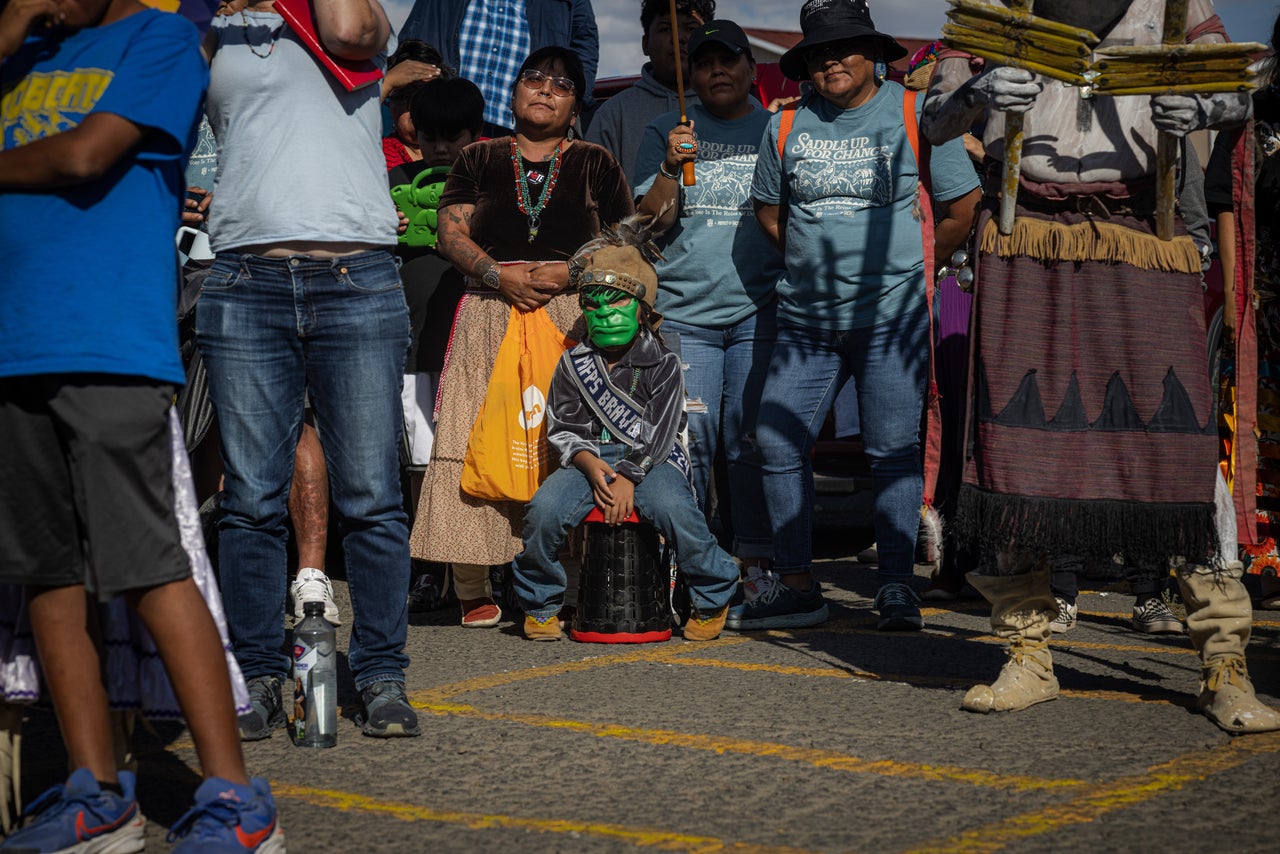
Sharon Chischilly for HuffPost
Miles down the road in Window Rock, some Navajo locals didn’t know anything about this walk. But they had strong feelings about voting in this presidential election.
“Don’t get me started about politics,” laughed Marjorie Francisco, 62, as she sipped her coffee in the lobby of the modest Quality Inn Navajo Nation Capital.
The hotel restaurant, called Diné Restaurant — Diné is a term Navajo people use to refer to themselves — was a local hot spot. People steadily streamed in from miles away, not to stay at the hotel but to come in for a hot meal of mutton stew and fry bread, and for some conversation.
Francisco, who has lived on the reservation for her entire life, said she plans to vote for Harris in large part because she’s a woman of color.
“She is a minority just like me,” she said. “It feels exciting because a lot of us minorities, we’re left behind. We’re on the back burners.”
Francisco said she doesn’t like the way Trump presents himself and that he hasn’t offered any plans for helping people who aren’t rich. “Us lower class, I consider myself as lower class,” she said. “I make less than $50,000 a year. It’s like, what are you [Trump] going to do for us?”
Francisco lives in a trailer in the town of Ganado with her husband, Ed. She said they just got water and electricity in their home two years ago, which was a big improvement over their previous way of life: driving an hour and a half to the town of Holbrook just to take a shower.
They shared stories of sleeping in their car in a Burger King parking lot for several nights when the miles-long dirt road to their home was buried in feet of snow. They talked about their community’s struggles with drugs and alcohol. Francisco works in a local hospital and said she’s seen young people coming in so strung out on meth or fentanyl that doctors had to tie them down and put them to sleep, just to calm them down.
Ed, who only gave his first name, said his local postal office had to remove its hand sanitizers because people were stealing them to drink them and try to get drunk from the rubbing alcohol in them. Both said they were glad to hear about the Protect the Sacred event down the road.
“It seems like nobody just, kind of, usually cares about the youth,” said Ed, before suggesting Harris is an exception. “I think that’s where Kamala comes in. She’s energetic. She does her moves. One of the ads where she was dancing, I was like, oh! She’s got some moves!”
Ed said he worries about the fate of his community if Trump wins, in part because of his ties to Project 2025. Among other things, the Heritage Foundation’s far-right 900-page presidential transition guidebook would take a wrecking ball to public lands.
“Our nation is at stake. Our homeland is at stake,” he warned. “If Trump gets back in there, we’re going to lose it.”
Ed said he doesn’t talk about it much, but that he and other elders in his community believe that Trump was prophesied in Navajo culture as someone who was going to return from another world to “take us all back, to have us lose everything.” In another Navajo prophecy, he said, a woman of color emerges as a leader who helps the tribe.
“I see that now,” he said. “I have a real strong cultural background with traditional knowledge. My grampy, he did these things, he said, ‘I’m not going to see it, but I think you will.’”
Ed didn’t give many details on this Navajo prophecy. He lowered his voice when he spoke of it, and said it’s not something he tells his friends that he sees happening.
“We don’t discuss this,” he said. Asked why he shared this story with HuffPost, Ed said simply, “You asked me about it.”
“You’re here talking about it. You come from Washington,” he added. “That’s just the kind of knowledge that we have.”
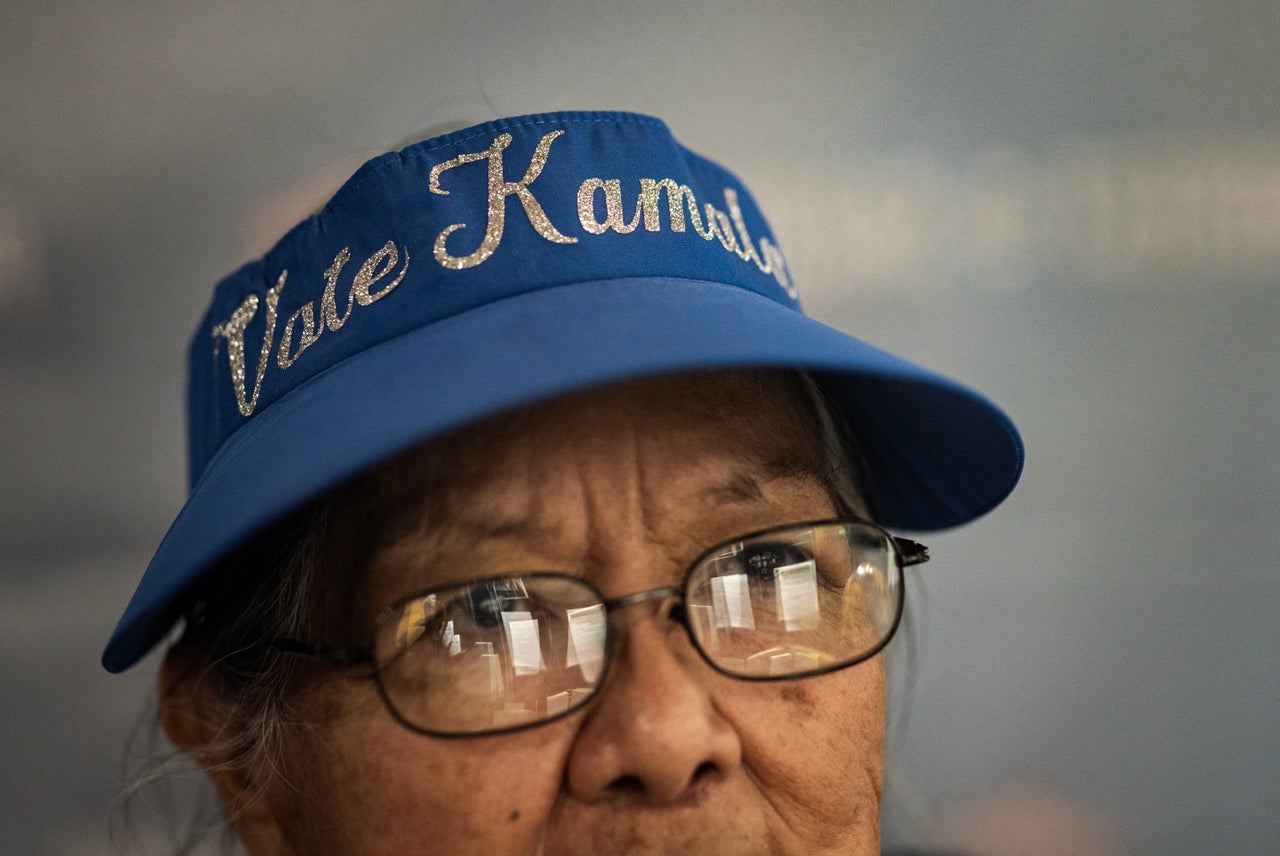
Sharon Chischilly for HuffPost
With early voting now underway in Arizona, Parrish and her team are making their final push to ensure tribal residents turn out to vote. She’s got 20 paid staffers on the ground working with five tribes in the state: Navajo, Hopi, White Mountain Apache, Tohono Oʼodham and San Carlos Apache.
She said her goal is to hit a 2% increase in Indigenous voter turnout over 2020. As part of her efforts to reach young voters, Parrish and her team have gone into 10 high schools in the last semester to talk directly to students, mostly seniors, about civics and voting. Arizona Native Vote will keep engaging with those students well beyond November.
“What we’re doing there is establishing that relationship. We are not a one-and-done group,” she said. Ultimately, she said, her goal is to grow Arizona Native Vote into a robust statewide operation like Fair Fight, the voting rights nonprofit led by Georgia politician and voting rights activist Stacey Abrams.
“I want Fair Fight, but I want to do it here in Arizona with tribes,” Parrish said, “because there’s no excuse why we can’t have that.”
Back at the Quality Inn, Francisco conceded that for all the years she’s been voting, she still feels disillusioned with the system. She said she feels like the Electoral College erases votes like hers, and brought up former Democratic presidential nominee Hillary Clinton losing the election in 2016 despite winning the popular vote.
But maybe for the first time, Francisco said she felt like her vote in 2020 really did matter.
“I always say, ‘Why do I vote?’” she said as Ed nodded nearby. “But then, I see that my vote does make a difference. My vote does make a difference.”

